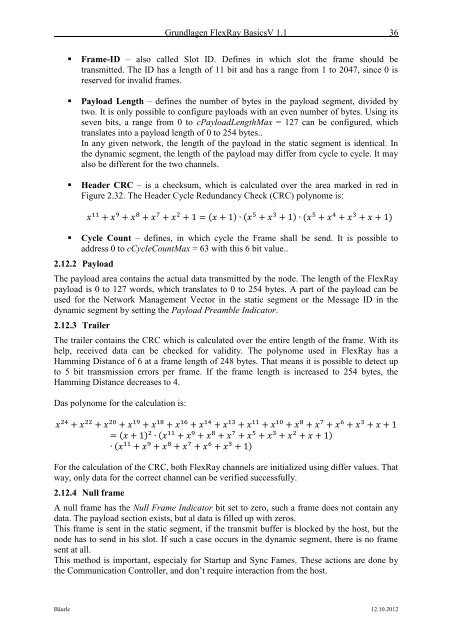Grundlagen FlexRay - Institut für Automatisierungs- und ...
Grundlagen FlexRay - Institut für Automatisierungs- und ...
Grundlagen FlexRay - Institut für Automatisierungs- und ...
Create successful ePaper yourself
Turn your PDF publications into a flip-book with our unique Google optimized e-Paper software.
<strong>Gr<strong>und</strong>lagen</strong> <strong>FlexRay</strong> BasicsV 1.1 36<br />
• Frame-ID – also called Slot ID. Defines in which slot the frame should be<br />
transmitted. The ID has a length of 11 bit and has a range from 1 to 2047, since 0 is<br />
reserved for invalid frames.<br />
• Payload Length – defines the number of bytes in the payload segment, divided by<br />
two. It is only possible to configure payloads with an even number of bytes. Using its<br />
seven bits, a range from 0 to cPayloadLengthMax = 127 can be configured, which<br />
translates into a payload length of 0 to 254 bytes..<br />
In any given network, the length of the payload in the static segment is identical. In<br />
the dynamic segment, the length of the payload may differ from cycle to cycle. It may<br />
also be different for the two channels.<br />
• Header CRC – is a checksum, which is calculated over the area marked in red in<br />
Figure 2.32. The Header Cycle Red<strong>und</strong>ancy Check (CRC) polynome is:<br />
( ) ( ) ( )<br />
• Cycle Count – defines, in which cycle the Frame shall be send. It is possible to<br />
address 0 to cCycleCountMax = 63 with this 6 bit value..<br />
2.12.2 Payload<br />
The payload area contains the actual data transmitted by the node. The length of the <strong>FlexRay</strong><br />
payload is 0 to 127 words, which translates to 0 to 254 bytes. A part of the payload can be<br />
used for the Network Management Vector in the static segment or the Message ID in the<br />
dynamic segment by setting the Payload Preamble Indicator.<br />
2.12.3 Trailer<br />
The trailer contains the CRC which is calculated over the entire length of the frame. With its<br />
help, received data can be checked for validity. The polynome used in <strong>FlexRay</strong> has a<br />
Hamming Distance of 6 at a frame length of 248 bytes. That means it is possible to detect up<br />
to 5 bit transmission errors per frame. If the frame length is increased to 254 bytes, the<br />
Hamming Distance decreases to 4.<br />
Das polynome for the calculation is:<br />
( ) ( )<br />
( )<br />
For the calculation of the CRC, both <strong>FlexRay</strong> channels are initialized using differ values. That<br />
way, only data for the correct channel can be verified successfully.<br />
2.12.4 Null frame<br />
A null frame has the Null Frame Indicator bit set to zero, such a frame does not contain any<br />
data. The payload section exists, but al data is filled up with zeros.<br />
This frame is sent in the static segment, if the transmit buffer is blocked by the host, but the<br />
node has to send in his slot. If such a case occurs in the dynamic segment, there is no frame<br />
sent at all.<br />
This method is important, especialy for Startup and Sync Fames. These actions are done by<br />
the Communication Controller, and don’t require interaction from the host.<br />
Bäurle 12.10.2012
















